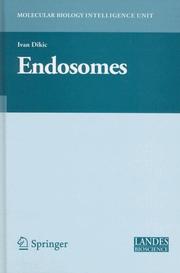| Listing 1 - 4 of 4 |
Sort by
|
Book
Abstract | Keywords | Export | Availability | Bookmark
 Loading...
Loading...Choose an application
- Reference Manager
- EndNote
- RefWorks (Direct export to RefWorks)
The release of cytokines, chemokines, and other immune-modulating mediators released from innate immune cells, including eosinophils, neutrophils, macrophages, dendritic cells, mast cells, and epithelial cells, is an important event in immunity. Cytokine synthesis and transportation occurs through the canonical protein trafficking pathway associated with endoplasmic reticulum and Golgi. How cytokines are released upon their exit from the trans-Golgi network varies enormously between cell types, and in many cells this has not yet been characterized. This issue delves into the plethora of cytokines released by innate immune cells, and where possible, shines light on specific mechanisms that regulate trafficking and release of Golgi-derived vesicles. Each cell type also shows varying degrees of dependency on microtubule organization and actin cytoskeleton remodeling for cytokine secretion. Understanding the mechanisms of cytokine secretion will reveal the inner workings of individual innate immune cell types, and allow identification of critical regulatory steps in cytokine release.
Cytokines. --- Chemokines. --- secretory granules --- Dendritic Cells --- GTPases --- SNAREs --- Neutrophils --- Epithelial Cells --- degranulation --- Macrophages --- Recycling endosomes --- Eosinophils
Multi
ISBN: 9783031315237 9783031315220 9783031315244 9783031315251 Year: 2023 Publisher: Cham Springer International Publishing :Imprint: Springer
Abstract | Keywords | Export | Availability | Bookmark
 Loading...
Loading...Choose an application
- Reference Manager
- EndNote
- RefWorks (Direct export to RefWorks)
This book covers the molecular structures and the cellular and in vivo function of endosomes and lysosomes, i.e. intracellular vesicles which are involved in many cellular processes such as endocytosis, intracellular trafficking, degradation of material from inside (e.g. autophagy) and outside the cell as well as exocytosis. Membranes of endolysosomal organelles contain an amazing number and diversity of ion channels. These ion channels are the topic of the present book that focusses on describing the structure, the biophysical properties, physiological functions of endolysosomal ion channels at the molecular, cellular and in vivo level. .
Histology. Cytology --- Biology --- History of human medicine --- Human physiology --- farmacologie --- biologie --- fysiologie --- cytologie --- histologie --- Endosomes. --- Ion channels. --- Lysosomes.

ISBN: 1281310182 9786611310189 0387399518 038739950X Year: 2006 Publisher: New York, NY : Springer New York : Imprint: Springer,
Abstract | Keywords | Export | Availability | Bookmark
 Loading...
Loading...Choose an application
- Reference Manager
- EndNote
- RefWorks (Direct export to RefWorks)
Endosomes are a heterogeneous population of endocytic vesicles and tubules that have captivated the interest of biologists for many years, partly due to their important cellular functions and partly due to their intriguing nature and dynamics. Endosomes represent a fascinating interconnected network of thousands of vesicles that transport various cargoes, mainly proteins and lipids, to distant cellular destinations. How endosomes function, what co-ordinates the molecular determinants at each step of their dynamic life cycle and what their biological and medical relevance is, are among the questions addressed in this book.
Endosomes. --- Receptosomes --- Cell organelles --- Cytology. --- Biochemistry. --- Medicine. --- Cell Biology. --- Biochemistry, general. --- Molecular Medicine. --- Clinical sciences --- Medical profession --- Human biology --- Life sciences --- Medical sciences --- Pathology --- Physicians --- Biological chemistry --- Chemical composition of organisms --- Organisms --- Physiological chemistry --- Biology --- Chemistry --- Cell biology --- Cellular biology --- Cells --- Cytologists --- Composition --- Health Workforce --- Cell biology. --- Molecular biology. --- Molecular biochemistry --- Molecular biophysics --- Biochemistry --- Biophysics --- Biomolecules --- Systems biology
Book
ISBN: 9781493914197 9781493914203 1493914197 1493914200 Year: 2014 Publisher: New York, NY Springer New York :Imprint: Humana
Abstract | Keywords | Export | Availability | Bookmark
 Loading...
Loading...Choose an application
- Reference Manager
- EndNote
- RefWorks (Direct export to RefWorks)
"This book contains a collection of protocols and techniques to analyze in vivo trafficking of endocytic/endosomal cargo, including lipids, fluids, proteins, and ligands, ultrastructural features of endosomes by high-pressure freezing/freeze-substitution and electron tomography, protein-protein interactions in the endosomal and endomembrane system, sorting defects in the transport of vacuolar storage proteins, function conservation of plant endosomal proteins, endosomal traffi cking during plant responses to pathogens, protein composition of endosomes and endocytic vesicles, ubiquitination of endosomal cargo proteins, and identifi cation of novel endosomal components by chemical genomics and proteomics."--
Endosomes --- Plant organelles --- Laboratory Manuals. --- Endosomes. --- Plant Proteins. --- Publication Formats --- Proteins --- Transport Vesicles --- Amino Acids, Peptides, and Proteins --- Cytoplasmic Vesicles --- Publication Characteristics --- Chemicals and Drugs --- Organelles --- Cytoplasmic Structures --- Cytoplasm --- Intracellular Space --- Cellular Structures --- Cells --- Anatomy --- Plant Proteins --- Laboratory Manuals --- Biology --- Health & Biological Sciences --- Cytology --- Receptosomes --- Endosome --- Receptosome --- Proteins, Plant --- Anatomies --- Cell --- Cell Components --- Cell Component --- Cellular Structure --- Component, Cell --- Components, Cell --- Structure, Cellular --- Structures, Cellular --- Organelles, Plant --- Protoplasm --- Cytoplasms --- Protoplasms --- Cytoplasmic Structure --- Structure, Cytoplasmic --- Structures, Cytoplasmic --- Organelle --- Endocytic Vesicles --- Endocytic Vesicle --- Transport Vesicle --- Vesicle, Endocytic --- Vesicle, Transport --- Vesicles, Endocytic --- Vesicles, Transport --- Gene Products, Protein --- Gene Proteins --- Protein Gene Products --- Proteins, Gene --- Subcellular Space --- Intracellular Spaces --- Space, Intracellular --- Space, Subcellular --- Spaces, Intracellular --- Spaces, Subcellular --- Subcellular Spaces --- Cytoplasmic Vesicle --- Vesicle, Cytoplasmic --- Vesicles, Cytoplasmic --- Life sciences. --- Plant science. --- Botany. --- Plant physiology. --- Life Sciences. --- Plant Sciences. --- Plant Physiology. --- Botany --- Plants --- Physiology --- Botanical science --- Phytobiology --- Phytography --- Phytology --- Plant biology --- Plant science --- Natural history --- Biosciences --- Sciences, Life --- Science --- Floristic botany
| Listing 1 - 4 of 4 |
Sort by
|

 Search
Search Feedback
Feedback About UniCat
About UniCat  Help
Help News
News